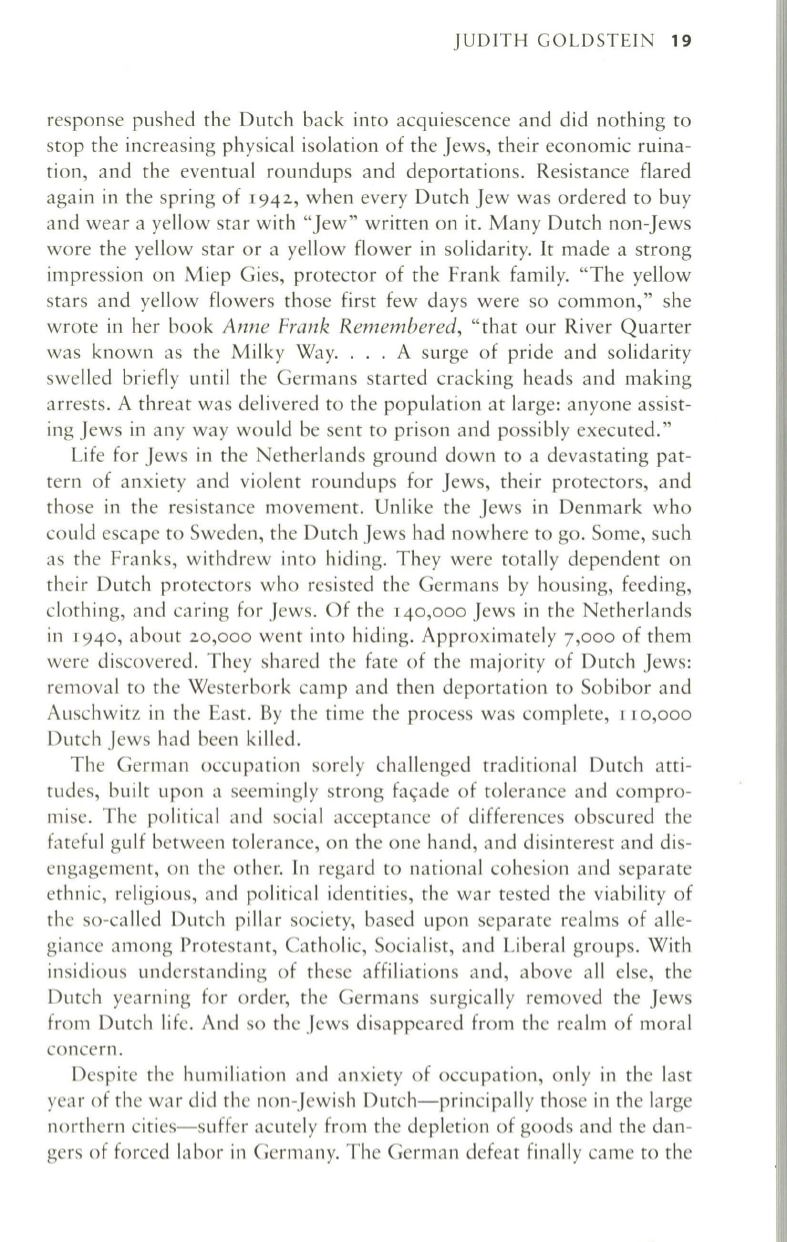
JUDITH GOLDSTEIN
19
response pushed the Dutch back into acquiescence and did nothing to
stop the increasing physical isolation of the Jews, their economic ruina–
tion, and the eventual roundups and deportations . Resistance flared
again in the spring of
I942,
when every Dutch Jew was ordered to buy
and wear a yellow star with "Jew" written on it. Many Dutch non-Jews
wore the yellow star or a yellow flower in solidarity.
It
made a strong
impression on Miep Gies, protector of the Frank family. "The yellow
stars and yellow flowers those first few days were so common," she
wrote in her book
Anne Frank Remembered,
"that our River Quarter
was known as the Milky Way... . A surge of pride and solidarity
swelled briefly until the Germans started cracking heads and making
arrests. A threat was delivered to the population at large: anyone assist–
ing Jews in any way would be sent to prison and possibly executed."
Life for Jews in the Netherlands ground down to a devastating pat–
tern of anxiety and violent roundups for Jews, their protectors, and
those in the resistance movement. Unlike the Jews in Denmark who
could escape to Sweden, the Dutch Jews had nowhere to go. Some, such
as the Franks, withdrew into hiding. They were totally dependent on
their Dutch protectors who resisted the Germans by housing, feeding,
clothing, and caring for Jews. Of the
140,000
Jews in the Netherlands
in
I940,
about
20,000
went into hiding. Approximately
7,000
of them
were discovered. They shared the fate of the majority of Dutch Jews:
removal to the Westerbork camp and then deportation to Sobibor and
Auschwitz in the East. By the time the process was complete,
I IO,OOO
Dutch Jews had been killed.
The German occupation sorely challenged traditional Dutch atti–
tudes, built upon a seemingly strong fa\=ade of tolerance and compro–
mise. The political and social acceptance of differences obscured the
fateful gulf between tolerance, on the one hand, and disinterest and dis–
engagement, on the other. In regard to national cohesion and separate
ethnic, religious, and political identities, the war tested the viability of
the so-called Dutch pillar society, based upon separate realms of alle–
giance among Protestant, Catholic, Socialist, and Liberal groups. With
insidious understanding of these affiliations and, above all else, the
Dutch yearning for order, the Germans surgically removed the Jews
from Dutch life. And so the Jews disappeared from the realm of moral
concern.
Despite the humiliation and anxiety of occupation, only in the last
year of the war did the non-Jewish Dutch-principally those in the large
northern cities-suffer acutely from the depletion of goods and the dan–
gers of forced labor in Germany. The German defeat finally came to the


